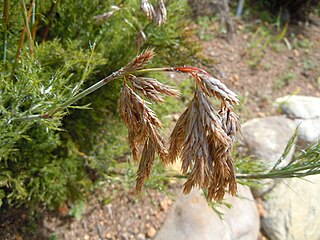
Cortaderia is a genus of South American and Central American plants in the Poaceae grass family.

The Restionaceae, also called restiads and restios, are a family of flowering plants native to the Southern Hemisphere; they vary from a few centimeters to 3 meters in height. Following the APG IV (2016): the family now includes the former families Anarthriaceae, Centrolepidaceae and Lyginiaceae, and as such includes 51 genera with 572 known species. Based on evidence from fossil pollen, the Restionaceae likely originated more than 65 million years ago during the Late Cretaceous period, when the southern continents were still part of Gondwana.

Agathosma is a genus of about 140 species of flowering plants in the family Rutaceae, native to the southern part of Africa. Common names include buchu, boegoe, bucco, bookoo and diosma. Buchu formally denotes two herbal species, prized for their fragrance and medicinal use despite their toxicity. In colloquial use however, the term is applied to a wider set of fragrant shrubs or substitutes.

Phylica is a genus of plants in the family Rhamnaceae. It contains about 150 species, the majority of which are restricted to South Africa, where they form part of the fynbos. A few species occur in other parts of southern Africa, and on islands including Madagascar, the Mascarene Islands, Île Amsterdam, Saint Helena, Tristan da Cunha, and Gough Island. Phylica piloburmensis from the Burmese amber of Myanmar, dating to around 99 million years ago during the mid-Cretaceous, was originally described as the oldest fossil member of the genus, but subsequent studies contested its assignment to the genus Phylica and even to the family Rhamnaceae, with one study placing it in the separate genus Nothophylica.

Willdenowia is a small genus of flowering plants in the family Restionaceae described as a genus in 1790. The entire genus is endemic to the fynbos of the Western Cape Province of South Africa.
Anthochortus is a group of plants in the Restionaceae described as a genus in 1837. The entire genus is endemic to Cape Province in South Africa.

Askidiosperma is a group of plants in the Restionaceae described as a genus in 1850. The entire genus is endemic to Cape Province in South Africa.

Ceratocaryum is a group of plants in the Restionaceae described as a genus in 1836. The entire genus is endemic to Cape Province in South Africa.
Mastersiella is a group of plants in the Restionaceae described as a genus in 1930.

Thamnochortus is a group of plants in the Restionaceae described as a genus in 1767. The entire genus is endemic to Cape Province in South Africa.

Cannomois grandis is a species of rush-like flowering plant in the genus Cannomois, native to the Cape Provinces of South Africa. It has gained the Royal Horticultural Society's Award of Garden Merit as an ornamental.
Neville Stuart Pillans was a South African botanist.









